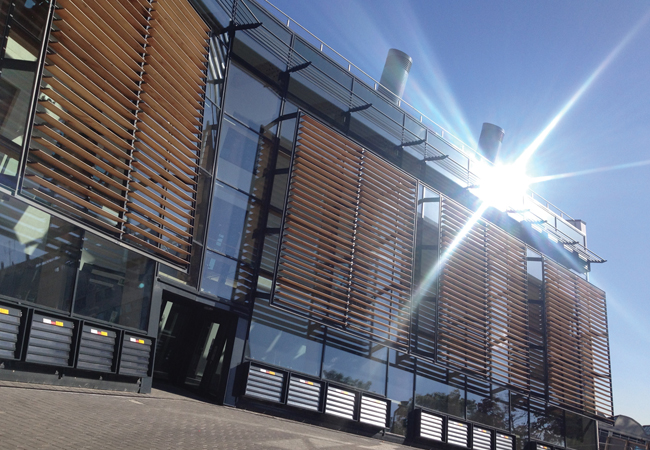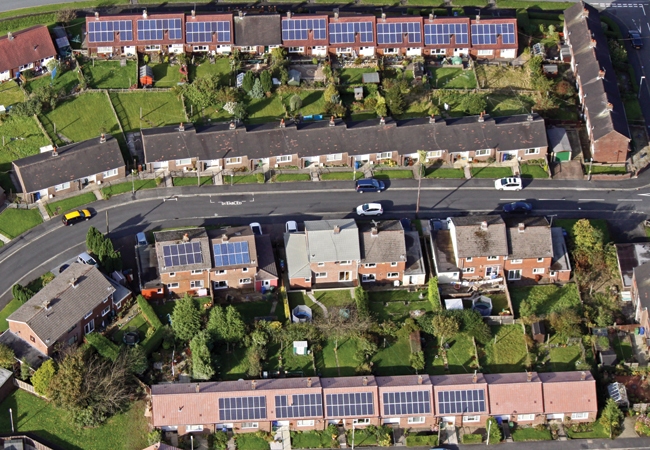
Credit NEIL MITCHELL/ SHUTTERSTOCK
Empower is a new approach to optimising energy performance in domestic buildings. It works by managing energy demand and supply across a community or portfolio of connected buildings, rather than merely optimising energy demand and supply in individual properties.
The technology is being developed and piloted by a consortium led by telecommunications software company e2E Services and energy specialists Encraft, supported by the University of Nottingham, and Bath & West Community Energy (BWCE). An initial pilot project in Wiltshire is being part-funded by Innovate UK.
The theory is simple (see Figure 1). As all energy managers know, smart building controls and management systems can often unlock significant benefits for individual buildings. However, if you can connect multiple buildings, new opportunities emerge – for example, supplying electricity or heat generated on one site directly to another, or storing energy in one location knowing there will be demand in a neighbouring building in the near future.
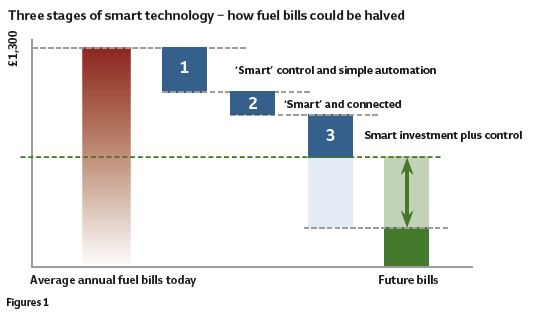
At the moment, most of these optimisation opportunities are lost in the UK energy market, because the system is designed from the top down and controlled centrally. It simply cannot cope with the complexity of optimising energy performance at multi-building – or community – level.
Even greater opportunities emerge when we move beyond instantaneous optimisation of energy use to consider the potential benefits of targeted investment in energy technologies, such as battery storage, local generation and demand management (step 3 on Figure 1). Easy access to energy data from across a community of buildings can show where investments in these technologies add most value and, hence, improve the economics and benefits. The kind of practical improvement unlocked by community energy management is illustrated in Figure 2.
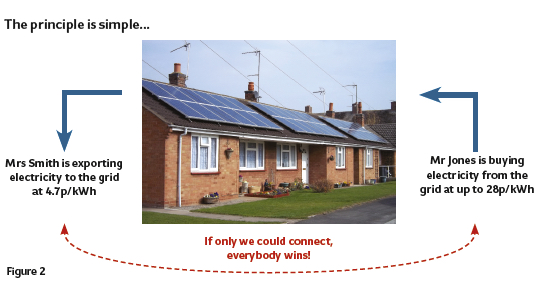
Currently, it is entirely possible that a household with a solar PV system installed can be exporting to the grid and being paid less than 5p per unit for its electricity, while – within a few metres – another household without solar is paying up to 28p per unit, in the worst cases, but typically 15p. If the two households could connect, it should be possible to do a deal that benefits all – for example, Mr Jones agrees to buy electricity from Mrs Smith at 12p per unit.
Of course, this is only the simplest potential revenue stream; if communities get organised, they could, theoretically, access national markets for demand and frequency response – switching off appliances at times of peak demand to help avoid the need to dispatch more generation, much like large industrial customers do.
Customers and communities able to access the commercial energy market can also benefit by shifting demand to times when energy is cheaper and dispatching local energy generation when prices are high. However, there are three main reasons this kind of arrangement is not yet happening:
-The costs of the IT and controls to manage these arrangements are too high
-Regulations prevent efficient commercial arrangements
-Householders may be sceptical about engaging with systems that take a degree of control over their energy use.
The Empower pilot project is challenging all of these obstacles. Working with the University of Nottingham, e2E Services has developed a control algorithm that takes data from cheap ‘off the shelf’ monitoring devices in homes. This data is then used to send control signals to a selected subset of devices in individual properties across the community that have ‘opted in’ to the service (Figure 3). This cuts the cost of the control solution and makes community-level optimisation economic.
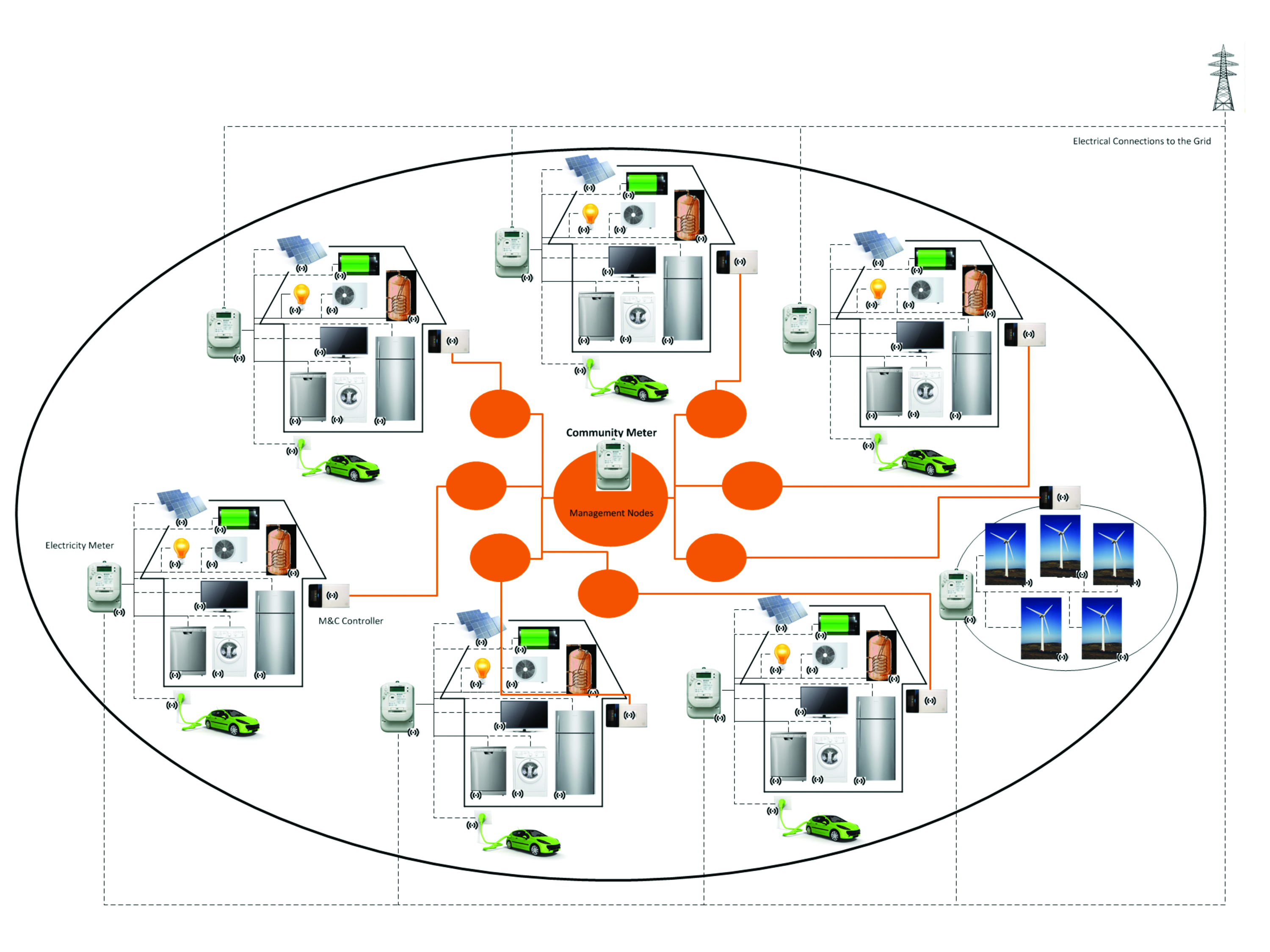
Figure 3 - The Empower Model
The initial results of this simulation have been very encouraging (see Figure 4, page 31). Modelling at the University of Nottingham demonstrates 18%-27% savings for a group of five houses – all with solar PV and batteries – over a week in February, using real weather and energy-price data for the period, with the range of savings dependent on the (user-set) constraints on appliance switching.
Initially, Empower is focusing on demand shifting and trading electricity within the community via a local intermediary, but there is no reason why later versions cannot include demand-and-frequency response capabilities.

Encraft is working with BWCE to develop and test business models and commercial arrangements that enable individual households to benefit from the technology and these potential savings. There are major regulatory issues, however, because any organisation needs an electricity supply licence to bill householders for energy, and this is expensive. However, Encraft has demonstrated that, with such a licence – which also gives the community access to the commercial energy market and half-hourly electricity prices – further savings of 8-25% are possible on individual annual fuel bills.
Access to the half-hourly market and the ability to bill customers enable the management solution to establish dynamic local tariffs, which can be used to drive control algorithms and incentivise customer behaviours. The economics of the model depends on the willingness of customers to delegate control of certain devices to Empower; typically, these will be significant items such as solar PV systems, batteries, and appliances for which the time of use is not critical, such as tumble driers.
Clearly, the inclination of householders to opt in is vital to the success of this kind of solution. For this reason, the project is piloting Empower across 12 buildings (10 houses and two commercial buildings) for three months this summer. The pilot will not only demonstrate if the simulated outcomes are replicable in reality, it will also be an opportunity to get behavioural feedback and start to gauge customer reaction to this kind of approach.
The economics of the model depends on the willingness of customers to delegate control of selected devices to Empower – typically, solar PV systems and batteries
There has been no difficulty in finding volunteers for the pilot, but the initial view of the project team is that local community engagement and leadership – above all trust – are vital to this kind of project and technology, which is why the support of BWCE has been so important.
The major regulatory challenge will lie in reconciling this need for local trust and leadership with the costs and risks associated with acquiring an energy supply licence. Encraft has carried out extensive research into viable models for running community energy companies in the UK and has concluded that a minimum of around 25,000 customers is necessary to support the costs of obtaining and maintaining a full retail energy supply licence. It is possible, without a full licence, to manage domestic supplies collectively on a smaller scale for defined situations – for example, apartment blocks or small private wire networks – but there aren’t enough situations like these to support the costs of the development and marketing of a potential mass-market technology such as Empower.
Of course, the problem with running a community energy solution for 25,000 customers is that the levels of trust and engagement that characterise smaller communities are long gone with projects of this scale. The challenge, therefore, is to find ways of building trust across much larger numbers of customers or to bring down the cost of complying with regulations. The good news is that there are signs that the latter is beginning to happen.
The government and the UK energy regulator, Ofgem, have made limited attempts to make the process cheaper – for example, they published a Community Energy Strategy in January 2014, which included the concept of a ‘licence lite’ for community-based energy companies. More practically, the continued entry of new players into the energy market is resulting in greater willingness by incumbents to innovate. Ovo and First Utility, for example, have interesting offers to communities – including ‘white label’ community energy models – and on using smart energy technology.
Meanwhile, the team behind Empower is already thinking beyond its Wiltshire pilot to a world in which community-level optimisation of energy systems is the norm.
Encraft and e2E have just started a second project – also funded by Innovate UK through the Energy Catalyst scheme – to develop a sub-station-level control algorithm that will make it possible for the distribution networks to manage multiple community energy schemes across a city or sub-region.
The emerging world of smart networks and smart grids is creating significant opportunities for technical and commercial innovation across the world.
Matthew Rhodes is managing director of Encraft.
Paula Quintela is project technical lead for Empower at e2E Services.


